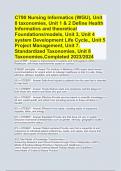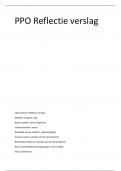C790 Nursing Informatics (WGU), Unit
8 taxonomies, Unit 1 & 2 Define Health
Informatics and theoretical
Foundations/models, Unit 3, Unit 4
system Development Life Cycle., Unit 5
Project Management, Unit 7.
Standardized Taxonomies, Unit 8
Taxonomies,Completed 2023/2024
goal of EBP - Answer is improvement of systems and microsystems within
healthcare, with these improvements based on science
STEEEP principles - Answer The Institute of Medicine (IOM) expert panel issued
recommendations for urgent action to redesign healthcare so that it is safe, timely,
effective, efficient, equitable, and patient-centered
(S) in STEEEP - Answer Safe-Avoid injuries to patients from the care that is intended
to help them.
(T) in STEEEP - Answer Timely-Reduce waits and sometimes harmful delays for
both those who receive and those who give care.
(E) in STEEEP - Answer Effective-Provide services based on scientific knowledge to
all who could benefit, and refrain from providing services to those not likely to
benefit.
(E) in STEEEP - Answer Efficient-Avoid waste, including waste of equipment,
supplies, ideas, and energy.
(E) in STEEEP - Answer Equitable-Provide care that does not vary in quality
because of personal characteristics such as gender, ethnicity, geographic location,
and socioeconomic status.
(P) in STEEEP - Answer Patient-centered Provide care that is respectful of and
responsive to individual patient preferences, needs, and values, and ensure that
patient values guide all clinical decisions.
ACE Star Model of Knowledge Transformation
Advancing Research and Clinical Practice through Close Collaboration (ARCC)
Model of Evidence-Based Practice in Nursing and Healthcare
Johns Hopkins Nursing Evidence-Based Practice Model and Guidelines
Iowa Model of Evidence-Based Practice
,Stetler Model of Research Utilization - Answer FOCUS: EBP, research use, and
knowledge transformation processes
DESCRIPTION: Direct a systematic approach to synthesizing knowledge and
transforming research findings to improve patient outcomes and the quality of care
Address both individual practitioners and healthcare organizations Focus on
increasing the meaningfulness and utility of research findings in clinical decision
making
Promoting Action on Research Implementation in Health Services (PARiHS)
Vratny and Shriver Model for Evidence-Based Practice Pettigrew and Whipp Model
of Strategic Change
Outcomes-Focused Knowledge Translation
Determinants of Effective Implementation of Complex Innovations in Organizations
Ottawa Model of Research Use - Answer FOCUS: Strategic and organizational
change theory to promote uptake and adoption of new knowledge
DESCRIPTION:Trace mechanisms by which individual, small group, and
organizational contexts affect diffusion, uptake, and adoption of new knowledge and
innovation
Premise is that interventions, outcomes evaluations, and feedback are important
methods to promote practice change
Collaborative Model for Knowledge Translation between Research and Practice
Settings
Framework for Translating Evidence into Action
Knowledge Transfer and Exchange
Canadian Institutes of Health Research Knowledge Translation within the Research
Cycle Model or Knowledge Action Model
Interactive Systems Framework for Dissemination and Implementation - Answer
FOCUS: Knowledge exchange and synthesis for application and inquiry
DESCRIPTION: Structure ongoing interactions among practitioners, researchers,
policy-makers, and consumers to facilitate the generation of clinically relevant
knowledge and the application of knowledge in practice
All parties are engaged in bidirectional collaboration across the translation continuum
Knowledge Transformation - Answer (Ace Star Model)
is defined as the conversion of research findings from discovery of primary research
results, through a series of stages and forms, to increase the relevance,
accessibility, and utility of evidence at the point of care to improve healthcare and
health outcomes by way of evidence-based care.
Ace Star Model - Answer These five points are discovery research, evidence
summary, translation to guidelines, practice integration, and evaluation of process
and outcome
clinical practice guidelines (CPGs) - Answer The IOM defines clinical guidelines as
"systematically developed statements to assist practitioner and patient decisions
about appropriate health care for specific clinical circumstances.
,usability - Answer 1.Increased user productivity and efficiency 2.Decreased user
errors and increased safety 3.Improved cognitive support
human factors - Answer is "the scientific discipline concerned with the understanding
of interactions among humans and other elements of a system, and the profession
that applies theory, principles, data and methods to design in order to optimize
human well-being and overall system performance."
In healthcare, human factors might concern the design of a new operating room to
better support teamwork and patient flow.
ergonomics - Answer used interchangeably with human factors by the HFES in
Europe but in the U.S. and other countries its focus is on human performance with
physical characteristics of tools, systems, and machines
i.e. power drill fitting in hand
Human-computer interaction (HCI) - Answer is the study of how people design,
implement, and evaluate interactive computer systems in the context of users' tasks
and work
usability - Answer is often used interchangeably with HCI when the product is a
computer but usability also concerns products beyond computers. Usability is also
more focused on interactions within a specific context or environment for a specific
product.
Formally, the ISO defines usability as the extent to which a product can be used by
specific users in a specific context to achieve specific goals with effectiveness,
efficiency, and satisfaction.
allows users to achieve goals
joint cognitive systems - Answer imply that information is shared or distributed
among humans and technology. This framework is useful for examining teamwork in
healthcare where team members work together on patient care
Health Human-Computer Interaction (HHCI) Framework - Answer Humans or
products can initiate interactions. The information is processed through either the
product or the humans according to characteristics. The recipient then reacts to the
information; for example, a healthcare provider could read and respond to email from
a patient or a product might process interactions after the "enter" key is pressed.
Iterative cycles continue as humans behave and products act according to defined
characteristics. Goals and planning are implicit within the tasks displayed in the
framework.
discount usability methods - Answer reduce the number of required users in usability
projects and to use early design prototypes.
, These methods offer economies of time, effort, and cost and can be completed at
any point in the systems life cycle.
Two common techniques are heuristic evaluation and think-aloud protocol.
Heuristic evaluations - Answer compare products against accepted usability
guidelines to reveal major and minor usability issues.
think-aloud protocol - Answer also involves a small number of users and has them
talk aloud while they interact with a product. Users voice what they are trying to do,
indicate where interactions are confusing, and provide other thoughts about the
product during interactions.
This allows a detailed examination of the specified tasks, in particular to uncover
major effectiveness issues.
used in conjunction with other techniques
task analysis - Answer generic term for a set of more than 100 techniques that range
from a focus on cognitive tasks and processes (called cognitive task analysis) to
observable user interactions with an application (e.g., a systematic mapping of team
interactions during a patient code).
Task analyses are systematic methods that are used to understand what users are
doing or required to do with a product by focusing on tasks and behavioral actions of
the users and products.
These methods provide a process for learning about and documenting how ordinary
users complete actions in a specific context.
Methods of task analysis include the following: •Interviews •Observations
•Shadowing users at their actual work sites •Observing users doing tasks
•Conducting ethnographic studies or interviews
focused ethnographies - Answer concentrate on individuals' points of view, their
experiences and interactions in social settings, rather than on just the actions of
those individuals
During observations, detailed descriptions are generated with an emphasis on social
relationships and their impact on work.
Usability Questionnaires - Answer System Usability Scale (SUS)- industry standard,
10-scale
Questionnaire for User Interaction Satisfaction (QUIS)-computer system or
application assessed
Purdue Usability Testing Questionnaire-100 open ended questions
Software Usability Measurement Inventory (SUMI)-





